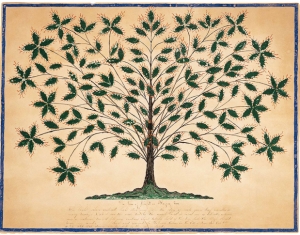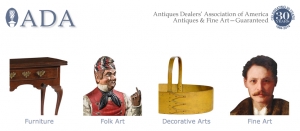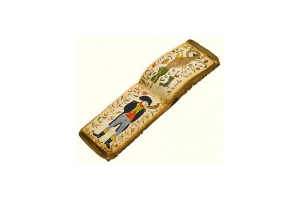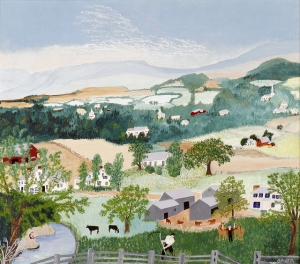|
Displaying items by tag: folk art
A 1930s shoeshine stand bedecked with gilded knobs and beaded fringe, which was once exhibited at the Museum of Modern Art — where it played a role in a famous director’s ouster — resurfaced last month and is headed back into the public eye.
The Fenimore Art Museum in Cooperstown, N.Y., purchased the imaginatively decorated stand, which was created by an Italian immigrant bootblack, Giovanni Indelicato, who ran a makeshift booth on lower Broadway and sometimes went by the name Joe Milone. The Fenimore bought it a few weeks ago for $10,000, after the New York folklorist Joseph Sciorra of Queens College, a specialist in Italian-American culture, alerted the museum, which has a specialty in American folk art, that the piece had re-emerged after decades in obscurity.

In this country, we don’t really go in for folk art – or at least, not in the way America does. Yes, there’s a collection of folk art on display at Compton Verney and another at the American Museum in Bath, but mostly it’s shown in local and regional museums. There’s nothing here on the scale or importance of the 150,000 works of art in the Shelburne Museum in Vermont or the American Folk Art Museum in New York City.
British condescension towards the whole subject was encapsulated in Jeremy Deller’s and Alan Kane’s insufferably smug installation Folk Archive, a personal collection of objects that served to illustrate for a metropolitan elite what the common folk like to do in their spare time. Had these two conceptual artists not made the blindingly obvious point that that the paraphernalia of Morris dancing and effigies of the Pope and Guy Fawkes reflect something or other about the nation’s collective unconscious, such folk artefacts would never have been allowed to pollute the sacred grove of high culture that is Tate Britain.
A 28 inch by 50 inch folk art rendering by the renowned self-taught artist Sam Doyle (1906-1985), titled St. Helena’s First Blak (sic) Midwife Trane (sic) By Dr. White, soared to $204,000 – a new world auction record for the artist – at Slotin Folk Art Auction’s Delta Blues to Visual Blues Auction, held April 26th and 27th at the Historic Buford Hall in Buford.
The painting, created from house paint on found roofing tin, was in excellent condition and depicted Mr. Doyle’s grandmother, a midwife, holding a newborn infant. It was the top lot of the April 26 session, dedicated to Visual Blues (folk art, typically from the Deep South). The April 27 session was themed Delta Blues and featured photographs, concert posters, records and more.

A groundbreaking exhibition originated by the American Folk Art Museum is on view from May 13 through August 17, 2014, at the Museum (2 Lincoln Square) before it embarks on a six-city US tour through early 2017. Self - Taught Genius: Treasures from the American Folk Art Museum posits an original premise that considers the changing implications of self-taught in the United States from a deeply entrenched and widespread culture of self-education in the early national period to its usage today to describe artists working outside the art historical canon and often in isolated circumstances. A fully-illustrated color catalog with essays by the curators, published by the American Folk Art Museum and Marquand Books, accompanies the exhibition. A website about the exhibition can be found at www.selftaughtgenius.org.
“This exhibition serves as a landmark,” commented Anne-Imelda Radice, Ph.D., Executive Director, “by locating the genesis of a field that has grown and become even more complex than ever before, and by clarifying its scope and substance. Self - Taught Genius: Treasures from the American Folk Art Museum provides new insight into the critical role of artists all-too-often overlooked.”
Winslow Homers in the shadow of a defunct Beech-Nut baby food plant. A Rembrandt, Picasso, Rubens and Renoir up the hill from a paper mill. The founder of the Hudson River School vying for attention amid baseball memorabilia and old farm machinery.
There are plenty of treasures to be found among the collections of lesser-known, off-the-beaten-path art museums dotting upstate New York. But they're well worth the trek for anyone looking for great art in unexpected places, whether it's the rolling, bucolic countryside typical of many areas or the industrial grittiness of riverside mill towns.
The American Folk Art Museum announced that it will open an annex for its collection and library in Long Island City, Queens, near the LaGuardia Performing Arts Center. The 17,000-square-foot facility, which is expected to open early next year, will provide the museum with extra space for storage and exhibitions.
In 2001, the Folk Art Museum opened its monumental Tod Williams and Billie Tsien-designed building on West 53rd Street in Manhattan. The museum soon fell into financial turmoil and in 2011, was forced to sell the building to the Museum of Modern Art and move to a smaller location in Lincoln Square. The Museum of Modern Art has since decided to raze the Folk Art Museum’s former home to make way for an upcoming expansion.
Founded in 1961, the American Folk Art Museum is devoted to traditional folk art and contemporary self-taught artists. Its collection includes over 5,000 objects from the 18th century to the present.
For the entirety of its 21-year run, the Outsider Art Fair has been held during the winter months. This year, the show, which highlights Outsider, Self-Taught, and Folk Art, will take place in the spring, from May 8 through May 11 at Chelsea’s Center 548, the former home of the Dia Art Foundation in New York City. The show will coincide with the New York edition of the Frieze Art Fair.
Eleven galleries who have been with the Outsider Art Fair since the first show will return this year including American Primitive, Ricco/Maresca, Marion Harris, and Carl Hammer. In total, 46 exhibitors from around the globe will participate in the 2014 Outsider Art Fair.
Founded by Sanford Smith, the Outsider Art Fair was acquired by Wide Open Arts in 2012. Since its inception, the Outsider Art Fair has been dedicated to showcasing works by artists who have been obscured, neglected, or overlooked.

Next month, the Antiques Dealers’ Association of America will kick off its inaugural online antiques show. From 10AM on Tuesday, April 1 until 10PM on Thursday, April 3, patrons can browse offerings on their computer, tablet or smartphone from any location. Participating dealers will offer everything from American antiquities and Americana to fine art, folk art, and decorative objects.
The Antiques Dealers’ Association of America was established in 1984 as a non-profit trade association. Its main objective is to enhance the professionalism surrounding the business of buying and selling antiques. Members include a variety of dealers who are committed to integrity, honesty and ethical conduct in the antiques trade. Membership is renewed on an annual basis and is subject to review by the Association’s Board of Directors. The Antiques Dealers’ Association also organizes lectures and seminars on various topics concerning antiques.
For more information about the Antiques Dealers’ Association of America’s online antiques show click here.

The American Folk Art Museum in New York has acquired a number of traditional folk art works as well as pieces by self-taught artists, enhancing its already-expansive permanent collection. With objects dating from the eighteenth century to the present, the museum is devoted to preserving, conserving and interpreting works of traditional and contemporary folk art.
Among the recent acquisitions is ‘The Peaceable Kingdom,’ a painting by the Quaker artist Edward Hicks. Hicks painted at least 62 versions of The Peaceable Kingdom over a period of more than 30 years. This particular version was given to Hicks’ daughter as a wedding present and remained in the Hicks family for many years. It was later represented by Edith Gregor Halpert and her pioneering American Folk Art Gallery, Terry Dintenfass, and the Sidney Janis Gallery. The painting was donated to the Folk Art Museum by Sidney Janis’ son Carroll, and his wife, Donna.
Other highlights include an elaborate architectural portrait by self-taught artist Achilles Rizzoli titled ‘The Kathredal’; a 19th-century watercolor book purchased at the recent Sotheby’s sale of the collection of Ralph O. Esmerian; an ethereal work by Thornton Dial that was gifted to the museum by the artist’s family; and a crayon and pencil drawing on pieced paper by the Mexican-American artist, Martín Ramirez, which was donated to the Folk Art Museum by David L. Davies, a former Museum trustee, and Jack Weeden, who had previously established a $1 million exhibition fund in their names.

The Milwaukee Art Museum is currently hosting ‘Uncommon Folk: Traditions in American Art,’ a comprehensive exhibition that celebrates the power, beauty, whimsy and wonder of American folk art. The show presents nearly 600 works by folk and self-taught artists who created art that was influenced by their communities and cultural traditions, rather than established art movements.
‘Uncommon Folk’ includes American paintings, drawings, sculpture, photography, textiles, furniture, and decorative arts by folk art luminaries such as Grandma Moses, Howard Finster and Sister Gertrude Morgan. All of the works on view belong to the Milwaukee Art Museum’s collection. The institution began collecting the work of folk and self-taught artists in the early 1950s after receiving two paintings by the Wisconsin-based artist, Anna Louisa Miller. During the 1960s and 1970s, when very few American museums were acquiring folk art, the Milwaukee Art Museum continued to acquire non-academic art through purchases and generous bequests.
Daniel Keegan, the director of the Milwaukee Art Museum, said, “The exhibition highlights the breadth and depth of the Museum’s world-class collection of American folk and self-taught art, from paintings and photographs to walking sticks and quilts. This eclectic grouping of American folk and self-taught art is a demonstration of the Museum’s long history of collecting works by untrained creators.”
‘Uncommon Folk: Traditions in American Art’ will be on view at the Milwaukee Art Museum through May 4, 2014.
|
|
|
|
|